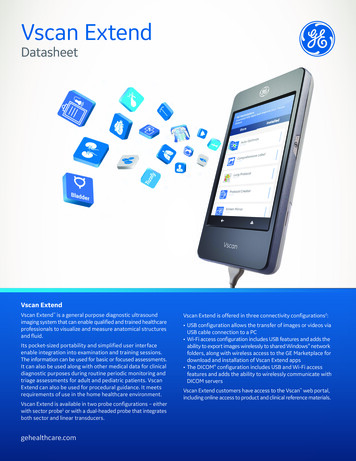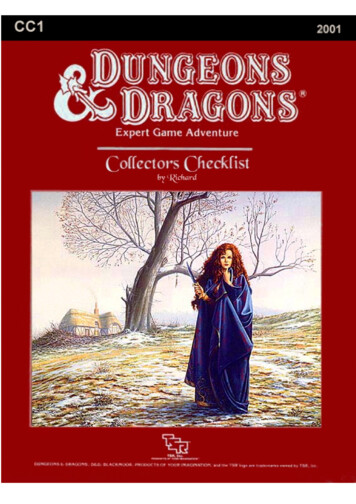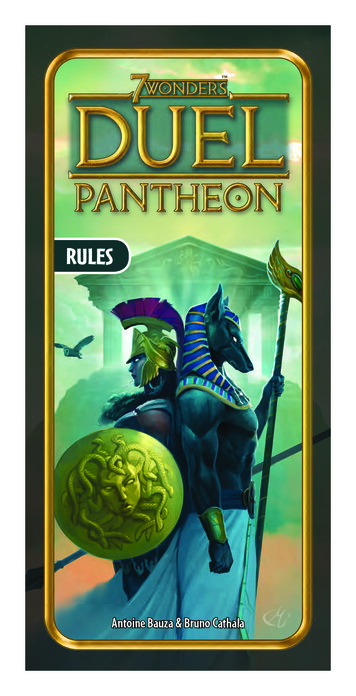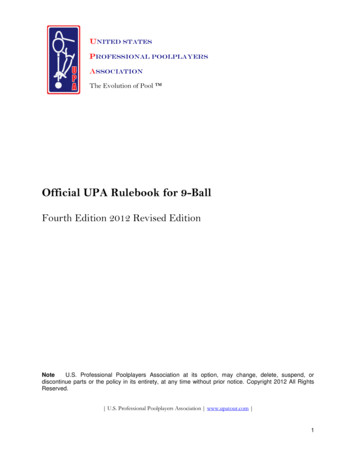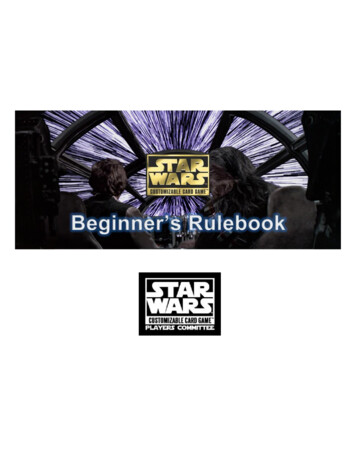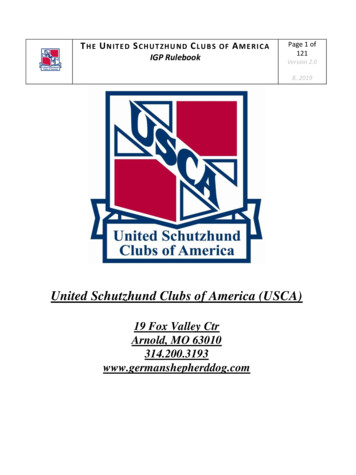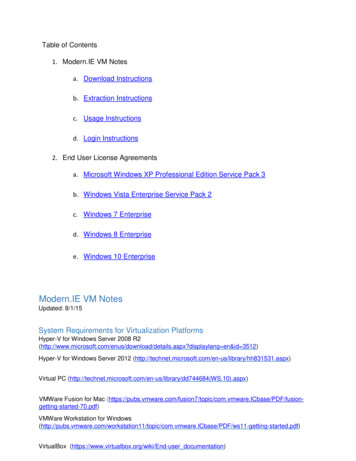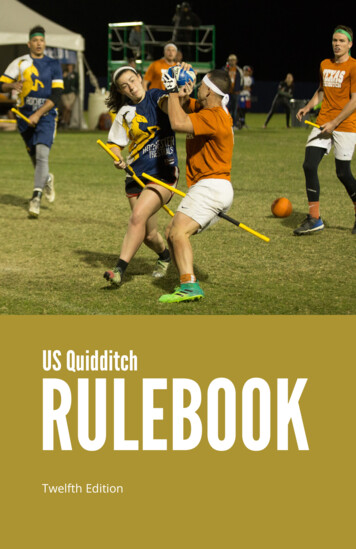
Transcription
US QuidditchRULEBOOKTwelfth Edition
12US QuidditchRULEBOOKTwelfth Edition
Copyright 2018 by US Quidditch. All rights reserved. No part of thisbook may be used or reproduced in any manner whatsoever without writtenpermission except in the case of brief quotations embodied in critical articlesand reviews.This book has not been written, prepared, approved, or licensed by Warner Bros,J.K. Rowling, or any of her publishers or licensees. It does not imply or claimany rights to her characters or creations, nor are the authors, staff members,or the publisher in any way affiliated with Warner Bros, J.K. Rowling, or anyof her publishers or licensees.Image creditsCover image Shirley LuImage on pg. 8 Elizabeth BarcelosImage on pp. 12 & 18 Sana SadiqImage on pg. 30 Jessica Jiamin LangImage on pg. 72 Isabella GongImages on pp. 166, 170 & 174 Shirley LuCover design by Alicia RadfordDiagrams by Mary Kimball, Crystal Hutcheson, and Katie BoneReferee signals by Eric AndresPublished by US Quidditch, Inc.ISBN-13: 978-1723104510ISBN-10: 1723104515To learn more about USQ, visit www.usquidditch.org
This rulebook is the result of the hard work of many people. Wewould like to thank everyone who has given input and insightto make it the best it can be. Particular thanks to the followingpeople for their work creating and editing the rulebook:Michael Clark-PolnerKym CouchClay DockeryMax D. GutierrezCynthia HoldenMary KimballSarah KneilingJared LeggettFredric Armstrong Nelson IVMatthew NiederbergerCaleb RagatzEric SchnierSarah WoolseyThanks also to the authors of previous editions,including Xander Manshel, Alex Benepe,Jared Kowalczyk, and Will Hack.
12
2ContentsAbout US Quidditch9Introduction11Basics of the Game13RULEBOOK1. Team Composition and Substitutions1.1. Leadership and Team Staff1.2. Rosters And Players1.3. Substitutions1.4. Substitution Area andThe Team Bench192023272. Equipment and Dimensions2.1. Field Lines and Marks2.2. Hoops2.3. Game Balls2.4. Brooms2.5. Player Equipment3132363840413. Game Procedures3.1. Preliminaries3.2. Starting the Game3.3. Stoppages3.4. Regulating Game Time3.5. Periods of Play3.6. Forfeits3.7. Suspended Games194949505256576060
Contents continued4. Scoring4.1. Goal Scoring4.2. Restarting After a Goal4.3. Broken or Fallen Hoops4.4. The Snitch Catch63636466685. Bludgers and the Knockout Effect5.1. The Mounted Broom5.2. Knocking Out Players5.3. Knockout Procedure5.4. Redirecting andCatching Live Bludgers5.5. The Third Bludger andKnockout Immunity5.6. Natural Motion737374777982856. Physical Contact and Interactions6.1. General Interactions6.2. Specific Contact6.3. Seekers and she Snitch Runner6.4. Right of Way6.5. Unsporting Behavior878795981001027. Boundaries and Balls7.1. Using the Balls7.2. Keeper Zone7.3. Offense, Defense, and Drives7.4. Pace of Play7.5. Boundaries105105109110111115
8. The Snitch Runner8.1. Role of the Snitch Runner8.2. The Snitch Runner’s Timing8.3. Snitch Runner Requirements8.4. Ruled as Down1211211211231249. Penalties9.1. Disciplinary Sanctions9.2. General Foul Procedures9.3. Timing of the Foul9.4. The Penalty Box9.5. Advantage9.6. Delayed Penalties12712713313413614214310. Game Officials10.1. The Officials10.2. Officials’ Calls10.3. Players and Officials145145149149Appendix A: Definitions151Appendix B: List of Fouls by Type159B-1. Individual FoulsB-2. Speaking Captain FoulsB-3. Forfeit Fouls159165165Appendix C: Referee Signals167Appendix D: Starting a Team171Appendix E: Changelog175
8USQ RULEBOOK
About US QuidditchOUR MISSIONUS Quidditch (USQ) is the national governing body for thesport of quidditch. USQ advances the sport by organizing eventsand programs that build community and empower all gendersto compete together.OUR VISIONWe envision a future where every person in the United States isaware of quidditch as a sport and has opportunities to play andengage at all levels.OUR CORE VALUES We establish the foundation for long-term sustainabilitythrough regulations, innovation, and expansion. We provide competitive opportunities for every level ofathlete. We build a safe, inclusive, and respectful community. We strive to be a leader in gender inclusivity for all age groups. We create meaningful community partnerships. We develop and empower future leaders.A 501(c)3 nonprofit founded in 2010, US Quidditch servesnearly 4,000 athletes on over 150 teams nationwide and provides a range of programs and services. These include hosting9
10USQ RULEBOOKregional and national championships; supervising regular seasoncompetition; supporting and certifying referees, snitches, andtournament directors; offering grants; and working to expandthe sport into younger age groups through outreach programsat the elementary, middle, and high school levels. Learn moreat www.usquidditch.org.THE GENDER MAXIMUM RULEDuring a seeker floor (which is the first 18 minutes of a quidditch game during regulation time and the first 30 seconds ofovertime), a team may not have more than four players whoidentify as the same gender in play. Upon the expiration of theseeker floor (which is when seekers are released) and for the entirety of any second overtime period, a team may not have morethan five players who identify as the same gender in play for theremainder of the period. The gender that a player identifies as isconsidered to be that player’s gender. This is referred to as thegender maximum rule.USQ accepts those who don’t identify within the binary gender system and acknowledges that not all of our players identifyas male or female. USQ welcomes people of all identities andgenders into our league.
IntroductionThe sport of quidditch continues to grow in popularity andmature as a dynamic and competitive game involving intensephysicality, complex strategy, and immense skill.As the sport expands and evolves, it is the responsibility of therulebook to keep up by addressing challenges, issues, and newmethods of play. The USQ Rules Team proactively addressesthe safety and gameplay concerns of the sport.Quidditch is no longer merely a backyard sport: it has beenplayed in all types of settings, from an open field to a stadiumwith an audience of thousands. Whatever the conditions ofplay, the rulebook needs to have a consistent answer for howthe game must work.The 12th edition of the USQ rulebook provides greater clarityand consistency than ever before. No sport’s rulebook will everbe perfect, but the goal of this rulebook is to provide the mostconsistent and easily replicable set of rules and regulations yet.For those of you who are new to the sport of quidditch, werecommend that you learn the basics from your friends, teammates, and the overview in Basics of the Game before you readstraight through this rulebook. Of course, the more ambitiousamong you are welcome to dive right in!11
12USQ RULEBOOK
Basics of the GameQUIDDITCH: AN OVERVIEWQuidditch is a mixed gender contact sport with a unique mix ofelements from rugby, dodgeball, wrestling, flag football, and othersports. A quidditch team is made up of at least seven athleteswho play with brooms between their legs at all times. While thegame can appear chaotic to the casual observer, once familiarwith the basic rules, quidditch is an exciting sport to watch andeven more exciting to play.POSITIONS OVERVIEWEach team has three chasers, two beaters, and one keeper in playat all times. Each team sends one seeker into the game at theend of the seeker floor (See: 3.4.2. Seeker floor).Chaser overviewChasers in play per team: ThreeGame ball used: QuaffleHeadband color: WhiteObjective: Throw, kick, or in any way pass the quaffle throughthe opposing team’s hoops to score ten points.Keeper overviewKeepers in play per team: One13
14USQ RULEBOOKGame ball used: QuaffleHeadband color: GreenObjective: Prevent opponents from throwing, kicking or otherwise propelling the quaffle through their team’s hoops.Beater overviewBeaters in play per team: TwoGame ball used: BludgerHeadband color: BlackObjective: Throw, kick, or in any way propel the bludgers todisrupt the flow of the game by “knocking out” other players.Seeker overviewSeekers in play per team: OneGame ball used: SnitchHeadband color: YellowObjective: Remove the snitch ball from the snitch runner toscore 30 points and end the period.GAMEPLAY OVERVIEWQuaffle playersA. The chasers and keepers, also known as quaffle players,attempt to score goals, and prevent the other team fromscoring goals, with the quaffle. Goals are worth ten pointseach.B. Quaffle players advance the ball down the field by runningwith it, passing it to teammates, or kicking it.C. Quaffle players defend by positioning or by initiatingvarious forms of legal physical contact with other quaffleplayers.
TWELFTH EDITION15D. While in their team’s own keeper zone, the keeper isimmune to the knockout effect and has several otherspecialized powers (See: 7.2.2. Keeper-specific powers).During this time, the keeper is considered to be a protectedkeeper. Otherwise, the keeper position is the same as thechaser position.Bludger playersA. The beaters use balls called bludgers to disrupt the flow ofthe game by “knocking out” any player from the opposingteam who does not have knockout immunity (See: 5.5.2.Knockout immunity).B. Any player hit by a bludger propelled by an opponent is outuntil they complete the knockout procedure, unless theyhave knockout immunity (See: 5.3.1. Knockout procedure).Snitch playersA. The seekers try to remove the snitch ball from the snitchrunner to score 30 points and end the period.B. The snitch is a ball attached to the waistband of the snitchrunner, a neutral athlete and official dressed in yellow,whose job it is to remain fair to both teams while avoidingcapture for as long as possible.C. Catching the snitch is worth 30 points and its captureends the period. The three periods are “regulation time,”“overtime,” and “second overtime.” If the score is tied afterany snitch catch, the game proceeds into the next period.
16USQ RULEBOOKFOULS OVERVIEWFrom the time that players enter the player area for a game untilafter the game has ended, players are forbidden from takingcertain actions called fouls. Players who commit a foul facedifferent consequences depending on the severity of the offense.Back to hoopsA back to hoops foul indicates that a player must cease activeplay and complete the knockout procedure (See: 5.3.1. Knockoutprocedure).Blue cardA blue card indicates that a player must spend one minute ofgame time in the penalty box and the player’s team must play aplayer down for this minute. If the opposing team scores beforethe minute expires, the player may be released early and reenterplay. Blue cards do not “stack” to become higher penalties.Yellow cardA yellow card indicates that a player must spend one minute ofgame time in the penalty box and the player’s team must play aplayer down for this minute. If the opposing team scores beforethe minute expires, the player may be released early and reenterplay. A player who receives two yellow cards in a single gamemust be issued a red card.Red cardA red card indicates that a player is barred from the rest of thegame and the player’s team must play a player down for two full
TWELFTH EDITION17minutes of game time.EjectionA referee may eject a player for egregious violations of the rules.
18USQ RULEBOOK
1. Team Composition and Substitutions1.1. LEADERSHIP AND TEAM STAFF1.1.1. Mandatory speaking captainEach team must designate one individual on the team’s officialroster to serve as the speaking captain for a game.A. The speaking captain has the power to speak for the teamwhen conversing with officials.i. Players may speak to officials on their own behalf.ii. Officials may direct any person to stop talking withany official.B. If the team’s speaking captain is unable to continue theduties of the position for any reason, their team must selectan alternate speaking captain.i. If the team’s original speaking captain for the gamelegally returns to the bench or pitch, they shall resumethe role of speaking captain.C. Speaking captains must not enter the pitch while play isnot stopped unless they are entering as an active player.i. If the speaking captain substantially illegally enters thepitch or affects play while illegally on the pitch, theyare encroaching on the pitch. Blue Card—Encroaching on the pitch19
20USQ RULEBOOK1.1.2. Team staffNon-playing members of the team, including non-playing coaches, are “team staffers.”A. Tournament directors may limit the number of teamstaffers allowed in the player area.i. This number cannot be limited to less than three.B. The names of team staffers must be communicated to thetournament director prior to the event if they are not onthe roster as a coach.C. Team staffers are not eligible to enter play.D. If a team staffer engages in any action that would resultin a penalty for a substitute, the team staffer shall receivethe same penalty.E. Team staffers must not enter the pitch while play is notstopped.i. If a team staffer substantially illegally enters the pitchor affects play while illegally on the pitch, they areencroaching on the pitch. Blue Card—Encroaching on the pitch1.2. ROSTERS AND PLAYERS1.2.1. RostersA. Each team is made up of between seven and twenty-oneplayers.i. A team must have seven eligible players to begin orcontinue a game.a. If a team is reduced to having fewer than seven eligible players at any time during a game, that team
TWELFTH EDITION21must forfeit the game.B. Team rosters must abide by all USQ regulations regardingrosters. Forfeit—Falling below seven eligible players1.2.2. PositionsA. A team shall have one keeper in play.i. Keepers must wear a green headband on their forehead.ii. Keepers may use the quaffle in any legal manner.B. A team shall have three chasers in play.i. Chasers must wear a white headband on their forehead.ii. Chasers may use the quaffle in any legal manner.C. A team shall have two beaters in play.i. Beaters must wear a black headband on their forehead.ii. Beaters may use the bludgers in any legal manner.D. During any seeker floor, a team must not have a seekerin play. Otherwise, a team must have one seeker in play.i. Seekers must wear a yellow headband on their forehead.E. Any players not in play are substitutes.i. Substitutes are not designated as being at any position.ii. Substitutes are not required to wear a headband.F. Players in the penalty box are considered in play and counttowards the position requirements for their teams.G. No penalty shall be given if teams are lacking a full complement of players either due to an active substitution orif a seeker accidentally neglects to enter the field at theend of the seeker floor. Speaking Captain Yellow Card—Illegal set of players in play Speaking Captain Yellow Card—Intentionally failing to send
22USQ RULEBOOKa seeker into the game1.2.3. Gender maximum ruleA. During a seeker floor, a team may not have more than fourplayers who identify as the same gender in play.i. A player serving penalty time is considered in play.B. Upon the expiration of the seeker floor, and for the entiretyof any second overtime period, a team may not have morethan five players who identify as the same gender in playfor the remainder of the period.i. A team may not have five players who identify as thesame gender in play until the initial seeker enters play.C. The gender that a player identifies as is considered to bethat player’s gender.D. If a team cannot field a full set of players because doing sowould cause that team to exceed the gender maximum, theteam may continue to play with fewer than the requirednumber of players on the field.i. A team may not start a game if they cannot field a fulllegal set of players.ii. One keeper, one beater, and one chaser are compulsoryin play, even when there are fewer than seven playersin play.a. This includes players in the penalty box.b. After conclusion of the seeker floor in any period,a seeker is also compulsory.iii. If the team regains the ability to legally field a full team,the team must do so.a. In this instance, the player enters from the bench. Speaking Captain Yellow Card—Illegal set of players in play
TWELFTH EDITION231.2.4. Correcting illegal sets of playersWhen the speaking captain receives a penalty for having an illegalset of players in play, they must correct the violation with as fewsubstitutions as possible before play is restarted.1.3. SUBSTITUTIONS1.3.1. Substitution procedureTo replace a player with a substitute while play is not stopped,the following conditions must be observed:A. The player substituting out is not knocked out.B. The player substituting out exits the pitch within the team’ssubstitution area and then promptly dismounts.i. The player must not dismount before crossing out ofthe pitch.ii. The player substituting out is no longer eligible to beknocked out once they have dismounted.C. If any other equipment must be traded (including headbands) it must be traded while off the pitch.D. The substitute entering play must mount the broom inthe substitution area and step onto the pitch before interacting with play.i. The substitute enters the pitch along the boundary ofthe team’s substitution area.ii. A substitution is complete when the substitute crossesthe boundary of the team’s substitution area into thepitch and is only touching the ground inside the pitch.a. The substitute is then immediately eligible to engagein gameplay and is eligible to be knocked out.E. The entering player receives any penalty card for violations
24USQ RULEBOOKof this procedure.F. If a player enters play through a substitution that violatesthis procedure, but has not yet interacted with play, theofficial shall call a substitution violation instead of anillegal substitution.i. If the entering player interacts with play before thecall, or before correcting the substitution violation, theymust be penalized for an illegal substitution.ii. A player who repeatedly commits substitution violationsmust be penalized for an illegal substitution. Repeat Procedure—Substitution violation Blue Card—Illegal substitution1.3.2. Position changePlayers may exchange positions by following the substitutionprocedure and changing headbands while dismounted in thesubstitution area.A. When a player switches positions with a teammate, theyshall be treated as participating in two separate substitutions. Substituting out at their old position in one, andsubstituting in at their new position in the other.1.3.3. Substitution guidelinesA. Substitutions may only be made while play is not stoppedwith the following exceptions:i. Replacing an ejected player (See: 9.1.6. Ejection).ii. Replacing an injured player (See: 1.3.4. Substitutionsdue to injury).iii. A keeper changing positions with another player in play
TWELFTH EDITION25when sent to the penalty box (See: 9.4.2. Proceedingto the penalty box).iv. Replacing a player in play with a fouling substitute(See: 9.4.5. Penalties to substitutes and team staffers).v. Correcting violations after receiving a penalty for havingan illegal set of players in play (See: 1.2.4. Correctingillegal sets of players).1.3.4. Substitutions due to injuryA. If a player is injured and play is not stopped, any substitution must follow all of the substitution procedure asoutlined in 1.3.1. Substitution procedure.B. Play must be stopped for an injury when a player in playis openly bleeding or is down and too injured to continueto play or substitute while play continues.i. Play should be stopped immediately if the injuredplayer is obstructing gameplay or has a serious injury,including any non-superficial head injury.ii. If the injury is not serious and the player is not obstructing active gameplay, the head referee should allow playto continue until stopping play would not significantlyadvantage either team or play moves into the area ofthe injured player.C. If a player is injured and play is stopped:i. The injured player may leave the pitch to be replacedby a substitute.a. If play is stopped for a player’s injury, that playermust leave the pitch.b. If the injured player is openly bleeding, they mustleave the pitch.1. The bleeding player is ineligible to return to play
26USQ RULEBOOKuntil receiving permission from an official, whomust be satisfied that the bleeding has stopped.c. The injured player’s broom is left on the field wherethey were when play was stopped.ii. Any injured player who leaves the pitch must be replacedby an eligible substitute.a. While play is stopped, the substitute replaces theplayer at the point indicated by the broom.b. If there is no eligible substitute that conforms tothe gender maximum rule, a team may play a playerdown instead of substituting.1. If this would leave a position without at leastone player, another player in play must changeto the position and location of the injured player.c. If a player is forced, by rule, to leave the pitch for anon-severe injury and there is no eligible substitute,that player may take their broom and resume playat the boundary of their substitution area.D. A player may not feign an injury for any reason. Yellow Card—Feigning an injury1.3.5. Substitutions between periodsTeams may make substitutions between periods without followingthe substitution procedure.A. Any player serving time in the penalty box may not besubstituted out between periods.B. If a player receives a penalty card for a foul occurringafter the head referee signaled the end of the period, itshall be treated as a penalty against a substitute, and the
TWELFTH EDITION27speaking captain may choose the position at which thepenalty shall be served. Speaking Captain Yellow Card—Illegal substitution betweenperiods1.4. SUBSTITUTION AREA AND THETEAM BENCH1.4.1. Team bench and substitution area restrictionsA. All substitutions must occur in the substitution area andnot in the team bench.B. Substitutes and team staff must remain in the team benchor substitution area whenever play is not stopped andmust not crowd the pitch boundary line unless about tosubstitute into the game.i. If a team is repeatedly illegally crowding the pitchboundary line, the officials may require all substituteson that team to remain in the team bench unless aboutto substitute into the game.C. Any extra equipment or property not necessary for playthat is brought into the player area by a team must be keptsecurely stored in the team’s bench.i. Any extra balls kept in the bench must be stored in abag or other storage container.1.4.2. Leaving the substitution area, bench, orplayer areaA. One substitute or team staffer at a time may leave the substitution area or team bench to check information with the
28USQ RULEBOOKscorekeeper or timekeeper but must neither interfere withthe scorekeeper or timekeeper’s duties, nor enter the pitch.B. The team’s speaking captain may leave the player area inorder to communicate with tournament staff.C. Any person in need of medical attention may leave theplayer area to receive it.i. All players who leave the player area in this way mayreturn to the game if they are medically cleared.ii. If necessary, anyone designated by the team’s speakingcaptain may leave the player area to attend to an injuredteammate.iii. In cases of head injuries, the head referee may, at theirdiscretion, require that the injured person leave theplayer area to receive medical attention.D. Intentionally and illegally leaving the substitution areaor bench with the intent of circumventing other rules isillegal circumvention. Blue Card—Illegal circumvention1.4.3. Sideline interferenceSubstitutes must not commit sideline interference.A. It is sideline interference if a substitute directly affectsplay when either of the following are true:i. The substitute is intentionally and illegally outside ofboth the substitution area and team bench.ii. The substitute failed to make every reasonable effortto avoid the play. Blue Card—Sideline interference
TWELFTH EDITION Red Card—Intentional sideline interference29
30USQ RULEBOOK
2. Equipment and DimensionsGOAL LINE21 YARDS15 YARDS36 YARDSKEEPER ZONE LINE24 YARDS33 YARDSPENALTY AREA PENALTY AREAKEEPER ZONE LINE66 YARDSGOAL LINE31
32USQ RULEBOOK2.1. FIELD LINES AND MARKS2.1.1. Boundary linesThe pitch consists of four boundary lines which form a 36 by66 yard rectangle.A. The 36 yard boundary lines are the endlines.B. The 66 yard boundary lines are the sidelines.i. The sideline closest to the scorekeeper’s table is the“scorekeeper’s sideline.”2.1.2. Midfield lineThe midfield line connects the midpoints of the sidelines.2.1.3. Keeper zone linesThere are two keeper zone lines, which run parallel to the endlines, connect the sidelines, and are positioned 12 yards awayfrom the midfield line on either side of it.2.1.4. Goal linesThere are two goal lines, which run parallel to the endlines,connect the sidelines, and are positioned 18 yards away fromGOAL LINE24 YARDSPENALTY BOXGOAL LINE6 YARDS30 YARDS6 YARDSPENALTY PENALTYAREAAREAPENALTY BOX6 YARDS 6 YARDS
TWELFTH EDITION33the midfield line on either side of it.2.1.5. Penalty boxesEach team has a penalty box outside of the pitch.A. Each box is a 6 by 6 yard square area that begins at themidfield line and extends along the scorekeeper’s sidelinein the direction of the team’s bench.2.1.6. Ball positionsThere are four ball positions directly on the midfield line.A. The first two ball positions are 3 yards of either side ofthe center of the midfield line.B. The other two ball positions are 9 yards on either side ofthe center of the midfield line.2.1.7. Substitution areasSCOREKEEPERGOAL LINEKEEPER ZONE LINE3 YARDSSUBSTITUTION AREAPENALTYAREA21 YARDSTEAM BENCHPENALTYAREASUBSTITUTION AREAGOAL LINETEAM BENCHKEEPER ZONE LINE21 YARDS
34USQ RULEBOOKEach team’s substitution area is a 21 by 3 yard rectangle outsideof the pitch and bordering their own keeper zone.A. One side of the substitution area is the scorekeeper’ssideline inside the keeper zone.B. The substitution area extends 3 yards away from thesideline.2.1.8. Team benchesEach team’s bench is a 21 by 3 yard rectangle that extends 3 yardsfarther from the pitch behind their substitution area.2.1.9. The player areaThe player area is a rectangle enclosing the pitch with the pitchat its center.A. This rectangle is:i. 48 yards wide and 72 yards long.B. The player area must be clear of obstacles and dangerousterrain.i. No tournament-specific obstructions, such as a scorekeeper’s table, may be set up within the player area.C. During gameplay, the player area is reserved for:i. Players on the active roster of the teams in play.ii. Referees and officials assigned to the game currentlyin play.iii. Tournament staff given access to the player area (attheir own risk) at the discretion of the head referee ortournament director.iv. Team staffers as designated in 1.1.2. Team staff.D. No spectators may enter the player area.
TWELFTH EDITIONPLAYER AREA72 YARDS48 YARDS352.1.10. Field markingsVarious parts of the pitch and surrounding area should be markedin a clear manner. These markings are usually made with conesor lines.A. The following must be marked in some way:i. The pitch boundary as described in 2.1.1.
36USQ RULEBOOKii. The midfield line as described in 2.1.2.iii. The keeper zone lines as described in 2.1.3.iv. The ball position farthest from the scorekeeper’s tableas described in 2.1.6.B. The following markings are optional, though recommended:i. The goal lines as described in 2.1.4.ii. The penalty boxes as described in 2.1.5.iii. The remaining ball positions as described in 2.1.6.iv. The team benches as described in 2.1.8.v. The player area as described in 2.1.9.vi. The hoop positioning as described in 2.2.3.a. These markings must not interfere with the stabilityof the hoops21 YARDS6 YARDS6 YARDS3 YARDS3 YARDS72 YARDS6 YARDS6 YARDS3 YARDS6 YARDS92 INCHES15 YARDS3 YARDS36 YARDS12 YARDS6 YARDS48 YARDS36 YARDS9 YARDS6 YARDSCENTER MARK24 YARDS66 YARDS2.2. HOOPS2.2.1. Hoop composition and construction
TWELFTH EDITION37A. Each hoop must be made up of a post and a circular loopattached to the top. These may be made of any materialother than metal or concrete and must not be dangerousto players.B. A hoop may be attached to a base to keep it upright.i. This base should not affect the hoop height.ii. Other than metal fasteners, the base must not be madeof hard metal or concrete.C. Hoops must be freestanding and able to withstand play.i. Referees must disallow any hoops or bases that theybelieve are dangerous to the players.2.2.2. Hoop shapeA. Each set of hoops must have posts of three differentheights.i. These heights must be 3 feet, 4.5 feet, and 6 feet.B. A hoop loop must be fastened to the top of each post.i. The inner diameter of each hoop loop must be between32 and 34 inches.ii. The attachment of the hoop loop must not make thetotal height of the post exceed the required post heights.2.2.3. Hoop positioningA. Three hoops are positioned on each goal line.i. The 6 foot hoop must be placed at the center of thegoal line.ii. The other two hoops are placed on the goal line, 92inches away from the 6 foot hoop on either side.iii. Facing either set of hoops from midfield, the 3 foothoop must be on the left and the 4.5 foot hoop must
38USQ RULEBOOKbe on the right.B. The hoop loops must be in line with the goal line.2.3. GAME BALLS2.3.1. The quaffleThe quaffle must be:A. A volleyball.B. Between 25.6 and 26.4 inches in circumference.C. The quaffle must maintain its spherical shape and mustbe neither inflated all the way nor so flat that the averageplayer could grip a bulk of the leather in one hand.2.3.2. BludgersThe three bludgers must be:A. Spherical balls made of flexible rubber or rubber-likecovers (such as dodgeballs).B. 8.5 inches in diameter, 26.7 inches in circumference.C. The bludgers must maintain
This rulebook is the result of the hard work of many people. We would like to thank everyone who has given input and insight to make it the best it can be.
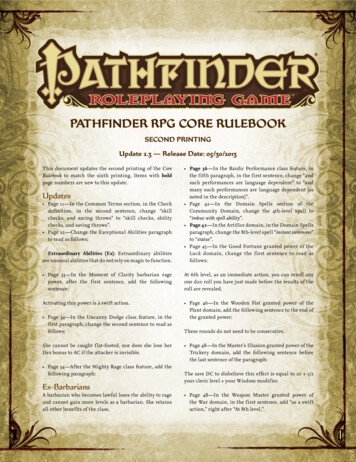
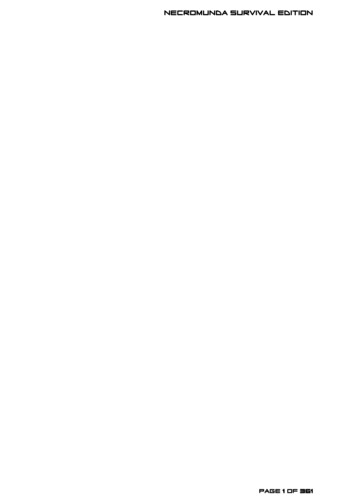
![March 3rd, 2017 [Manage Archive in Microsoft Outlook 2016]](/img/34/archive-outlook-2016.jpg)
